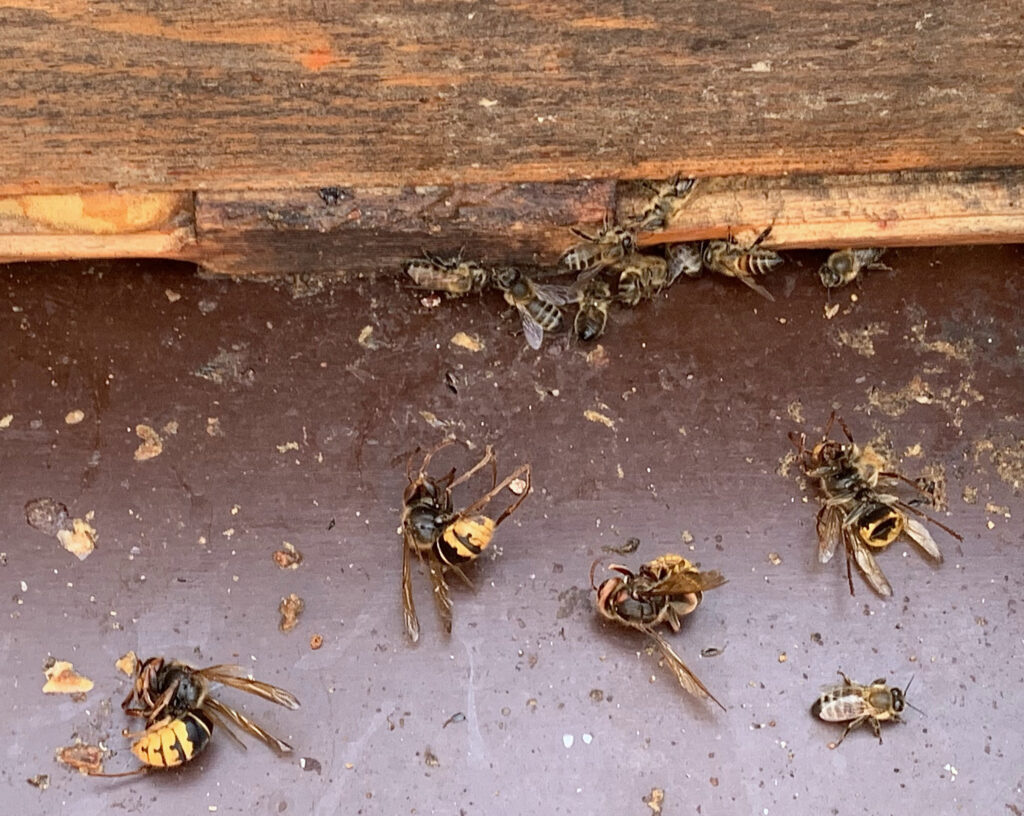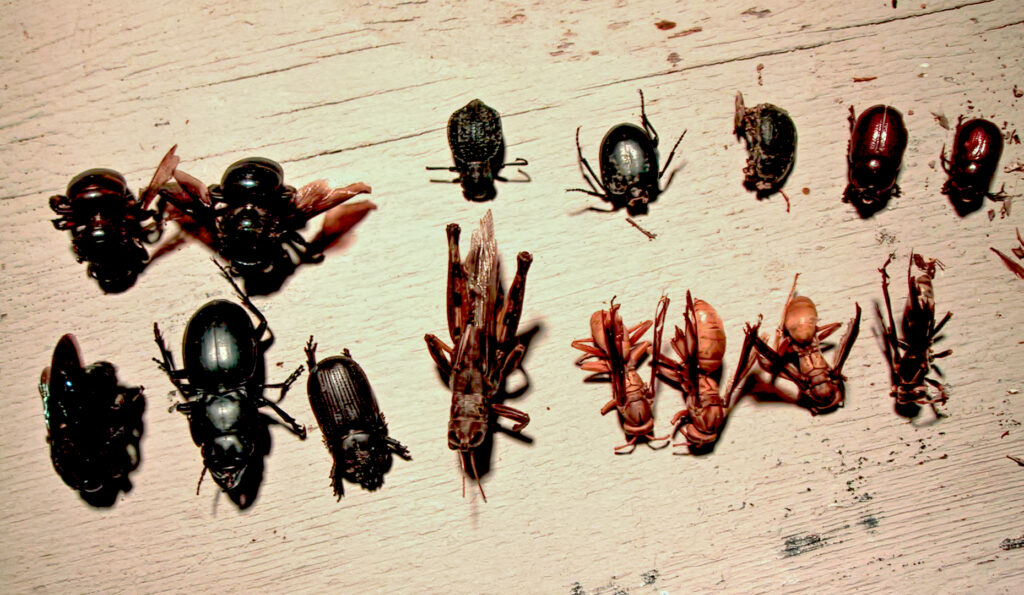Resistance against intruders
One of my bee colonies (Elgon, combinationof Buckfast and Monticola) started to superseed their queen, but the new queen evidently got lost. The colony ended up with egg-laying workers. I discovered that in August. It had several brood frames with drone brood in combs with worker-sized cells. It was not meaningful to save the colony, so I focused on saving the frames, ie I wanted the bees to hatch the drones but not to let them make more drone brood in worker comb. I removed all frames except those with drone brood.
During a check at the end of August, I noticed that the bees, even though they were not in balance as they lacked a queen, had a fighting spirit to keep their small colony clean from intruders.

There were four dead large European hornets (Vespa crabro) on the bottom board near the entrance.
I also observed that the bottom board was shining clean. The bottom board was not replaced or cleaned by me in spring. I rarely need to change bottom boards in the spring after winter. Varroa resistant Elgon bees clean them themselves.
This colony had not needed varroa treatment for two seasons. I’ve observed these things before, bees cleaning the bottom board and killing intruders. Most often, the dead intruders are outside the entrance on the ground. The bees manage to kill large hornets despite their small size.
Small size
Speaking of small size. The small cell size (4.9 mm) front figures, Dee and Ed Lusby south of Tucson in the Sonoran desert, Arizona, pointed out that the small bees that were the result of small sized cells were better at keeping out intruders such as wasps and hornets of different looks and sizes, and beetles of various kinds. They believed that the increased defense against intruders also affected the ability to get rid of smaller intruders such as varroa mites. Their bees had never been treated for varroa. I visited them several times, the first time in 2000.

I have also observed that bee colonies with me that kept varroa away well, cleaned their bottoms well.
Black thorax
You can see some small bees in the picture with the dead European hornets. The round middle body (thorax) is dark or black on some of them. This is what queens usually look like. This is because the thorax (middle body) lacks hair. Elgon bees has inherited this from the African Monticola bee. It seems this coloring of the thorax is more common among African bees. One thing we noticed in the first crossings with Monticola, and in subsequent generations, was the presence of black thorax. This is much more common with drones and worker bees than before the combination with Monticola, even today30 years after the first combination. But selection for varroa resistance has been going on all the time. I had never observed this black thorax on other bees than queens before the combination with Monticola. In drones and working bees, the dark thorax is due to black or very dark hair on the thorax.
Björn Lagerman, the Beescanning app-man, has observed that his colonies with Elgon combinations, those that have more of black thorax in worker bees and drones, have greater resistance to varroa.
Helping list for selecting resistance
From these observations, one can make the following list that can be helpful for selection of colonies to use in breeding for increased varroa resistance among honey bees.
2. Cleaned bottom board
3. Killed hornets close to the colony hive, done by the bees of the hive
4. Small bees (born in at least 5.1 mm cell size, preferably 4.9 mm)
5. Black thorax of the worker bees and drones.
1. However, the most important thing for the selection of varroa resistance besides just survival in spite of the precense of the mite without treatment, is low varroa level (degree of infestation) (below 3% in spring and later). The longer the treatment break before the measurement of the infestation rate, the better the breeding value if the colony has a lower infestation rate than 3%. I measure the degree of varroa level with the bee shaker jar, when I find it valuable https://www.elgon.es/varroalevel.html You can also use the Beescanning mobile app. It is becoming more common around the world.
Hello from Baltimore Erik. Our bees are ruthless against Euro hornets. I see the hornets every season dive bombing our colonies, and every year I find Euro hornets dead all over the apiary. We also see fewer and fewer deformed wing and darker thorax color. Still maintaining 100+ treatment free colonies in the urban landscape. Hope you are well…take good care